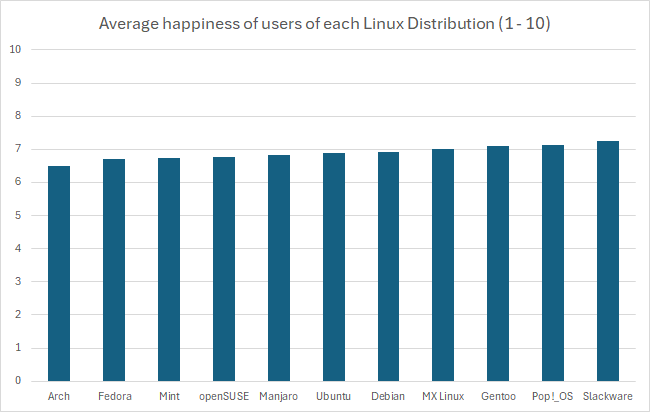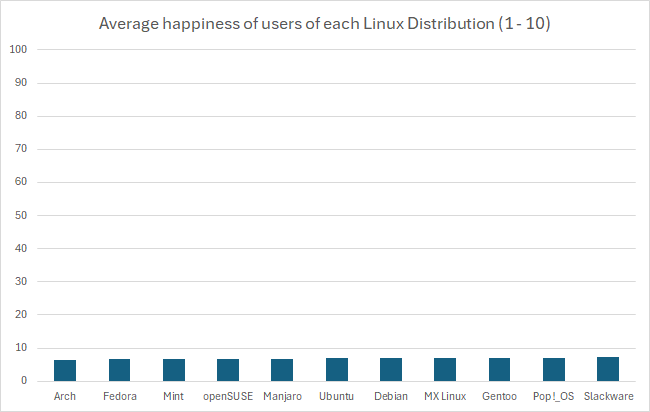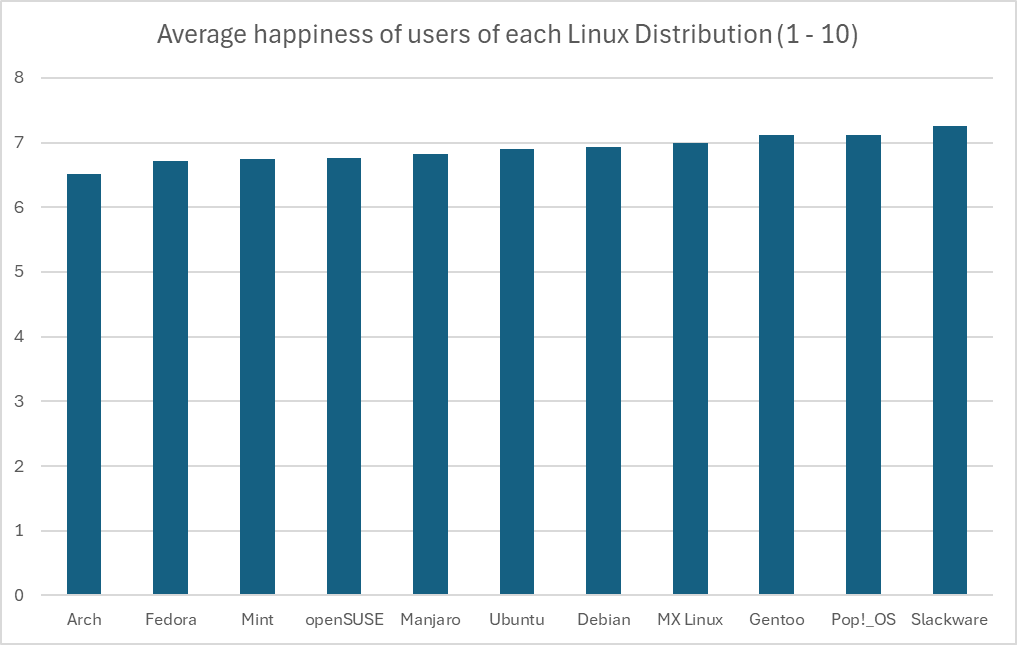lunduke
Oh. bye 👋
Bryan „trans people choosing pronouns is like the Picard 4 lights torture scene” Lunduke
Also substack
I’m ootl I think, what did he do?
Exactly.
Such polls / surveys are extremely questionable. I wouldn’t even know what rating to give, if someone asks me how happy I am. This is a dumb question to ask to begin with. Let alone everyone has a different standard to what 10/10 or 5/10 means. And then only 6000 (+ some) have been taken part.
I can’t believe this was a real poll / survey.
That was the longest “I am using arch btw” I have ever seen. And while I am on the topic, I am using arch btw.
Not exactly, I use EndeavourOS, almost Arch. But I use Firefox, BTW. I was more unhappy when I used Ubuntu and even more when I was using Windows before this. No idea what rating to give though. What even is 8/10 happiness??
You made the post so I didn’t have to!
smart
also it’s reported on by lunduke so it should be immediately discarded
Also the graph is pretty much zoomed in. It exaggerates the differences between the bars.
The following data was obtained from polling done between January 22nd and February 9th, 2023. A few details about the polling conducted:
6,022 people answered the questions.
This is significantly larger than the vast majority of national polls conducted during Presidential Elections in the USA (most of which have less than 2,000 respondents).
The poll was presented to audiences of several shows and news sites in order to obtain a large, diverse sample of computer nerds.
The questions were wide-ranging, 100% optional, and no personal data was collected.Let’s start from a very high level:
6,022 computer nerds & enthusiasts were asked the following simple question: “On a scale of 1 to 10, how happy would you say you are (in general)?”In polls the demographics of the participants are selected so they are statistically significant.
When you poll visitors to a website there’s no telling what biases might be at work. For example, Arch is a popular distribution so its prevalence in the results could simply be an indicator of that.
Last but not least, correlation does not necessarily mean causation, and that goes especially for an uncontrolled sample. There’s a famous example that says “100% of the people who drink water die after that”.
You can’t compare to the President Elections in the USA. The answers are very serious and with a huge impact, so people will choose wisely. And they are complete randoms. Compared to the question to nerds how happy they are in a rating between 1 and 10 and then connecting the happiness to the operating system they are using. It’s like asking how happy people are and then connecting this to the current president. Who said other factors didn’t play a role?
You can just take it for what it is: How people respond when asked to grade their happiness from 1 to 10. Of course it’s subjective, but it’s interesting that arch users rate their happiness lower overall.
I think its bullshit. There is no way of verifying if this is bullshit or not.
Same. I call bullshit. First of all, for me Lunduke = Bullshit. Second, the moment it said people voluntarily participated in this survey, you just know that the demography of the survey takers will be extremely biased.
@thingsiplay @superkret Here! Here!
I’m immensely sceptical of anything that comes from Lunduke.
I don’t really know what happened to him but he went kinda nuts.
Nicco Loves Linux made a pretty interesting video on him a month-ish ago. You might enjoy it if you’ve known Lunduke since when he was still nice.
Edit: Link to the video
This seemed interesting to me, so I prepared a cup of tea, sat down to watch, then quickly realised I’ve already seen this before, oops 😅
Thanks for the link regardless, I’m sure others are seeing it for the first time
Lol. Hope you found something else to enjoy with the tea.
Thanks for the link! I was trying to figure out the Lunduke complaints (I don’t know if I’ve ever heard of this guy before). This video did a solid job of catching me up.
Yeah, he was already on a weird path but after Covid he went down really hard.
I hope he will seek help and get betterI used to enjoy listening to him on YouTube simply because he didn’t yell in his videos like every other YouTuber. He had a bit of a Bob Ross vibe to him, but then he went off the deep end.
-
That’s a misleading Y-axis. The difference (in self-reported subjective happiness rating 1–10 too) is not as significant as the graphic implies visually.
-
Phew, I use Librewolf on Artix Linux. I’m safe 👍
+1
The difference (in self-reported subjective happiness rating 1–10 too) is not as significant as the graphic implies visually
Ah here is another one. So what? It makes the difference more distinguishable, which also the graph denotes numerically. Otherwise all Linux distros users would appear too flat to make any difference interpretable.
The fact that there are at least two such comments around here shows why teaching anything in schools is doomed to fail.
Even critical thinking skills are applied in a canned, thought-terminating fashion, similar to how XX/XY chromosomes are considered the only reality, in overconfident falsehood.
What a bizarre reply. It implies that the difference is statistically significant when it’s in fact much less so.
Otherwise all Linux distros users would appear too flat to make any difference interpretable.
That is the point. The graph obscures this.
Ah the statistical significance, which as everybody knows is assessed …visually? Mic drop
BTW I have another comment here, totally irrelevant to this discussion, that I bring up statistical siGnifiCAnsE as an example of confident falsehood. Thanks for proving me right lol
I’m not trying to do layman statistics. I’m stating that the graph obscures the magnitude of the difference between people’s ratings. You seem to be suggesting that I’m trying to do some kind of formal or specialist critique of the graph. I’m not. I didn’t go to school or anything and I am simply making a lay observation. If you disagree with it you can say without being so obfuscating yourself.
Although there is a common tip in critical thinking classes that manipulating the Y-axis range can lead to misleading presentation of a difference, I believe in this particular graph, which clearly provides numbers to compare, you can’t say it is misleading.
People can read and compare the values and draw their own conclusions. And I am saying that without any consideration of the distros discussed, since I am impartial to distros, I like all distros I have tried.
This “study” almost certainly must have way deeper assumptions- and metrics- related problems to start with, so even finding myself having this argument is preposterous. But I am just pointing out the misapplication of critical thinking guideline, and this is a valid point which I insist everyone who relies on to consider, if you care about critical thinking at all.
No one said you are doing layman statistics, the pasted comment is from another discussion, provided here for context, and for very good reasons. It aligns with obvious misconceptions about statistics that should be pointed out. Probability and statistics are thorny subjects that nonetheless are inevitable in order to understand the world surrounding us, material, social, and economic, so yes I will nitpick here and call out the misapplication of canned critical thinking thought-terminating cliches.
There’s not a lot of data to work with, and the kind of test used to determine significance is not the same across the board, but in this case you can do an analysis of variance. Start with a null hypothesis that the happiness level between distros are insignificant, and the alternative hypothesis is that they’re not. Here are the assumptions we have to make:
- An alpha value of 0.05. This is somewhat arbitrary, but 5% is the go-to threshold for statistical significance.
- A reasonable sample size of users tested for happiness, we’ll go with 100 for each distro.
- A standard deviation between users in distro groups. This is really hard to know without seeing more data, but as long as the sample size was large enough and in a normal distribution, we can reasonably assume s = 0.5 for this.
We can start with the total mean, this is pretty simple:
(6.51 + 6.71 + 6.74 + 6.76 + 6.83 + 6.9 + 6.93 + 7 + 7.11 + 7.12 + 7.26) / 11 = 6.897Now we need the total sum of squares, the squared differences between each individual value and the overall mean:
Arch: (6.51 - 6.897)^2 = 0.150 Fedora: (6.71 - 6.897)^2 = 0.035 Mint: (6.74 - 6.897)^2 = 0.025 openSUSE: (6.76 - 6.897)^2 = 0.019 Manjaro: (6.83 - 6.897)^2 = 0.005 Ubuntu: (6.9 - 6.897)^2 = 0.00001 Debian: (6.93 - 6.897)^2 = 0.001 MX Linux: (7 - 6.897)^2 = 0.011 Gentoo: (7.11 - 6.897)^2 = 0.045 Pop!_OS: (7.12 - 6.897)^2 = 0.050 Slackware: (7.26 - 6.897)^2 = 0.132This makes a total sum of squares of 0.471. With our sample size of 100, this makes for a sum of squares between groups of 47.1. The degrees of freedom for between groups is one less than the number of groups (
df1 = 10).The sum of squares within groups is where it gets tricky, but using our assumptions, it would be:
number of groups * (sample size - 1) * (standard deviation)^2Which calculates as:
11 * (100 - 1) * (0.5)^2 = 272.25The degrees of freedom for this would be the number of groups subtracted from the sum of sample sizes for every group (
df2 = 1089)Now we can calculate the mean squares, which is generally the quotient of the sum of squares and the degrees of freedom:
# MS (between) 47.1 / 10 = 4.71 // Doesn't end up making a difference, but just for clarity # MS (within) 272.25 / 1089 = 0.25Now the F-statistic value is determined as the quotient between these:
F = 4.71 / 0.25 = 18.84To not bog this down even further, we can use an F-distribution table with the following calculated values:
- df1 = 10
- df2 = 1089
- F = 18.84
- alpha = 0.05
According to the linked table, the F-critical value is between 1.9105 and 1.8307. The calculated F-statistic value is higher than the critical value, which is our indication to reject the null hypothesis and conclude that there is a statistical significance between these values.
However, again you can see above just how many assumptions we had to make, that the distribution of the data within each group was great in number and normally varied. There’s just not enough data to really be sure of any of what I just did above, so the only thing we have to rely on is the representation of the data we do have. Regardless of the intentions of whoever created this graph, the graph itself is in fact misrepresent the data by excluding the commonality between groups to affect our perception of scale. There’s a clip I made of a great example of this:

There’s a pile of reasons this graph is terrible, awful, no good. However, it’s that scale of the y-axis I want to focus on.

This is an egregious example of this kind of statistical manipulation for the point of demonstration. In another comment I ended up recreating this bar graph with a more proper scale, which has a lower bound of 0 as it should. It’s suggested that these are values out of 10, so that should be the upper bound as well. That results in something that looks like this:

In fact, if you wanted you could go the other way and manipulate data in favor of making something look more insignificant by choosing a ridiculously high upper bound, like this:

But using the proper scale, it’s still quite difficult to tell. If these numbers were something like average reviews of products, it would be easy in that perspective to imagine these as insignificant, like people are mostly just rating 7/10 across the board. However, it’s the fact that these are Linux users that makes you imagine that the threshold for the differences are much lower, because there just aren’t that many Linux users, and opinions wildly vary between them. This also calls into question how that data was collected, which would require knowing how the question was asked, and how users were polled or tested to eliminate the possibility of confounding variables. At the end of the day I just really could not tell visually if it’s significant or not, but that graph is not a helpful way to represent it. In fact, I think Excel might be to blame for this kind of mistake happening more commonly, when I created the graph it defaulted the lower bound to 6. I hope this was helpful, it took me way too much time to write 😂
Oh sport, and I thought I was the one beating on a dead horse here. I understand why people claim to take issue with the Y-axis range. I am just saying chart makers can zoom in to make a point, and it is not automatically misleading. That is all. Anyway, thanks for writing this. Looks like a lot of effort, and some of it will make sense in my stats coursework, thanks!
I am not trying to apply a “critical thinking guideline” I saw elsewhere. I’ve not taken any “critical thinking classes”. I’m more insulted that you think I couldn’t have possibly just thought of that comment myself. It’s not a particularly crazy comment to make, and I don’t see why any individual who knows how to read graphs couldn’t just happen to make that comment.
Anyway—sure, I never said the graph lied. Perhaps a better wording would be that, regardless of how the information is presented, I don’t think the difference in magnitude between people’s happiness ratings (ignoring the issues with how those ratings were collected and ascertained in the first place) is significant or particularly of note. The Y-axis is chosen so as to visually amplify this difference. I didn’t claim the data presented by the graph was untrue or that reading the graph correctly was too difficult if one wanted to read it properly.
I really did not mean to be insulting. I am just saying chart makers can choose to make a zoom in, and it is not automatically propaganda or something. All this has led people astray of the real issues, like WTF is measuring ‘happiness’ on a 1-10 scale, and what are the metric properties of this 1-10 scale. Then there are all the sampling issues and what have you. I just expected more people discussing this stuff rather than the Y-axis.
-
That’s strange, apart from installing it, Arch is pretty painless to run if you’re not careless
You’re assuming that Arch causes the unhappiness. Maybe unhappy people naturally tend to use Arch, so as to avoid further pain from painful distros like Pop! OS?.
Oh shit, I was miserable back when I installed Arch. Dang, you might be onto something there!
So… Arch makes sad people happy…?
No, that’s just bloat feelings
I dunno, I was pretty stoked installing Arch almost a decade ago after my spouse surprised me with a brand new PC he built for my birthday. Was also stoked installing Arch, in more recent years, on the PC I built.
And I’ve been at my most miserable in life while being a Windows user 🫠
lunduke is possibly the biggest asshole in the Linux space. do not share his garbage “journalism”.
Fuck that. I could not be happier with Fedora.
I love fedora but I do wish that GNOME had a better command line tool for opening windows on different workstations. I just want to automate more easily (I think Wayland is a factor too).
I could not be happier with Fedora.
It wasn’t trying to asses one’s happiness/satisfaction with their OS of choice, it was instead looking at the general life happiness of people, broken down by their OS of choice.
This checks out. I love fedora but I hate my life.
No worries. I’ll love you until you can love your life back, and maybe even after that.
I know the differences between these metrics are inconsequential because the happiness view doesn’t start at 0, but it still makes me want to shout “what the fuck are gentoo users so happy about” lol
Not needing to deal with arch users, also having nice reading time (compiling a Firefox update on a laptop)
Sometimes it’s hard to tell the difference between arch and some gentoo users
because the happiness view doesn’t start at 0
How is that so?
The axis is cut off below 6, so the difference between the columns’ size isn’t representative of the actual scale
The scale on the left doesn’t start at zero, so the difference is smaller than the size of the bars make it seem. The difference between #1 Slackware, and last spot Arch, is 0.75 points in a 0 to 10 scale, but the bar size of Slackware is about 2.5x bigger than the bar for the Arch users.
Fair. You know these figures right out from the graph don’t you?
Just to kind of demonstrate that idea, I’ve recreated the graph in Excel with the axis starting at 0. I think Excel might actually be to blame for this happening so much, its auto selection actually wanted to pick 6, gross.

This is indeed misleading. It has no numerical figures, and it wastes loads of ink and screen space. The other one is better structured as a chart. I a sorry you spent your time to demonstrate something we all know, but may be Excel has good reasons that cuts off the axis at 6.
Because it works and we didn’t need to change anything in the last 20 years. I don’t even think about it.
Whenever I try something else, problems come as soon as I want something that’s not default. Which is often.
I don’t even know how to install Gentoo. I did it two times, second time was when upgrading to 64bit architecture.
Fair enough, it’s just one of those distros you find a lot of those elitists in. Even had a “friend” tell me I wasn’t really a Linux user because I don’t use arch, then gentoo, then openbsd
Oh look, another Lunduke article. I’m sure there’s no bias at all. Nope.
In any case, I adore Arch and Firefox and am extremely happy with my Garuda install.
The real data point here is that Skackware users are happy.
I suspect it’s because they’ve mastered the art of not giving a fuck.
Yeah, that’s pretty spot on.
Slackware just does as it’s told and gets out of the way.
I wonder if Arch makes people unhappy or if unhappy people chose Arch.
Looking at the distro/happiness graph, it’s probably an age thing.
Younger computer users are less happy.Probably the latter. I’ve been a two or three on the scale since before I used Arch or Firefox.
Anecdotal, but I’m at a relative low point lately and I have set today aside for installing Arch.
Let’s go Pop!_OS! We’re #2! We’re #2!
Coming for #1 baby
That will happen after the stable release of cosmic de
This is one of those correlation != causation things, hm?
It might be more a case of the “average” Arch user being more sensitive to small quirks/bugs or certain defaults. Arch is at least comparatively unbiased, which might be why these users pick Arch in the first place.
I would personally agree with where Arch is because I prefer a distribution that mostly works out of the box and already made a lot of the decisions for me that I don’t want to be bothered with. I do still customize quite a few elements to my (sometimes very specific) liking, but I also like that I don’t have to do anything when it comes to configuring my disk layout, or configuring zram, or install and configure
fwupdor other packages that kind of just make sense to have.But I don’t really see why Arch users can’t be as happy with their choice as I am with mine, unless the only reason they “use Arch btw” is that they think that’s unironically something to brag about (or peer pressure, but that shouldn’t be a thing I hope).
This is just fun with statistics. I don’t think your Linux distro has a big impact on your overall happiness in life, but of course you can order the results by any parameter you like.
Often, it’s a third factor that influences both, in this case probably age, which influences happiness and distro choice.
Or maybe having the time and inclination to install Arch correlates with being in a bad place in your life right now.
I know I was tinkering with Linux all day when I was procrastinating and locked away in my room for days.having the time and inclination to install Arch correlates with being in a bad place in your life right now.
True for me. I’m using Arch because I don’t have a system that can run Gentoo ;P
Actually I’ve oscillated between the two for many years. Every few years I switch to the other one and enjoy it for a few. … Only, now I’m stuck on a laptop that would melt if I tried to put Gentoo on it v.v I hope some day I will have a real computer again v.v Among other things 😅 😞
in this case probably age
Arch: for the young’uns with some fire left in them that just discovered open source and want to stick it to M$ and show off in front of friends.
Debian: When those people grow up and start having to do actual work on their computers instead of work on their computers…
I went through that cycle over the last 25 years. Thought I was hot shit running Slackware on a ThinkPad 380 when all my friends were on Windows 98. Then I got better things to do than running configure scripts all day and tweaking the UI yet again.
As a user of Debian and Arch: I don’t know how to feel
I run Slackware because I got better things to do than configure my system.
The installation was a bit more involved than Debian cause you have to set up grub and install flatpak yourself, but then it just sits there, works and never really changes, which is nice.
It’s designed to not surprise you and let you do with it whatever you want, including nothing.I installed Gentoo on an already ancient IBM Thinkpad with a Pentium 100. It had to use Debian boot floppies to kick off the installation process.
I don’t think I’d do that today.
These results seem freaking bizarre and I’m highly skeptical. You’re telling me that Slackware users, freaking SLACKWARE, are the happiest? And Firefox is the least happy? I am so much happier using Firefox than have been with Chrome for at least a decade.
The question wasn’t how happy users are with their distro, but in general. My theory is, people who have a lot of great things going on in their life (wife, kids, social life) don’t bother installing Arch.
And people who have no time install gentoo? Pull the other one :D
Gentoo installation is time-consuming, but Gentoo maintenance usually isn’t. Just allocate portage a couple of cores while you do something else with the rest of the computer. Or leave the update to run overnight, if you’re on a potato.
How is that different from Arch other than being an actual PITA having to compile stuff?
I wonder if people using steam decks know they are running Arch.
I’m not sure if that’ll be good or bad.
Wow, no need to make this personal. /s
You’d be surprised.
Yeah, I just set it and forget it. Understand I started using Linux with a really new system and an Nvidia card so archlinux was just soo much easier than hacking away at a distro too old to support my hardware.
My system is older now but I’m just going to leave it on there because other distros kind of do things I don’t like, small things but still enough for me to stick with arch.
As a former slackware aficionado, I’d have to say that the general mood of the users and development team was super chill. Hell, the name slackware comes from “slack”, the goal of the Church of the SubGenius. The whole thing is a meme that’s been going steady for decades.
I had the privilege of meeting Patrick and much of the core Slackware group at the KDE 4.0 release party. They are all awesome.
I can expect that users that tolerate the Slackware style are also those that are pretty laid back to begin with. Probably they were happier people already, and using slackware just vibes with them.
oh Bryan Lunduke? can someone spare me a grain of salt before I click the link? appreciaet it.

























